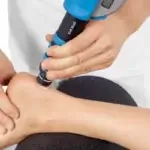Physical rehabilitation following injury, surgery, or due to chronic conditions can be a long and often challenging journey. However, advances in medical technology are continually reshaping the recovery landscape. One such advancement that’s making a significant impact is shockwave therapy. This blog post delves into how shockwave therapy is revolutionizing the rehabilitation process.
Table of Contents
Understanding the Fundamentals of Shockwave Therapy
What is Shockwave Therapy?
Shockwave therapy is a non-invasive treatment that delivers high-energy sound waves to injured or damaged areas of the body. These sound waves induce cavitation, creating microbubbles that expand and burst, causing a force that stimulates the body’s natural healing mechanisms.
How does Shockwave Therapy Enhance Recovery?
Shockwave therapy plays a significant role in the recovery process, primarily through three mechanisms:
- Promotion of Regeneration: The energy from the shock waves stimulates the body’s cells, promoting the repair and regeneration of damaged tissues.
- Increased Blood Flow: Shockwave therapy promotes the development of new blood vessels, improving blood supply to the affected area and accelerating the healing process.
- Pain Management: The therapy helps manage pain by reducing the production of pain transmitters and stimulating the release of natural analgesics.
The Impact of Shockwave Therapy on Rehabilitation Outcomes
Enhancing Recovery Speed and Efficacy
Shockwave therapy has shown promising results in rehabilitation, with numerous studies highlighting its potential to speed up the recovery process and improve treatment outcomes. For instance, research has demonstrated its effectiveness in restoring patients with tendon injuries, muscle strains, bone fractures, and post-operative healing.
Case Studies: Shockwave Therapy in Action
Let’s look at some specific applications of shockwave therapy in rehabilitation:
- Tendon Injuries: A 2019 study published in the American Journal of Sports Medicine found that patients with Achilles tendinopathy who received shockwave therapy showed significant improvements in function and pain reduction.
- Bone Fracture Healing: Research published in the Journal of Orthopaedic Surgery and Research in 2020 showed that shockwave therapy could significantly accelerate healing in patients with non-healing fractures.
- Post-Operative Rehabilitation: A study in the Journal of Physical Therapy Science reported that applying shockwave therapy in the early post-operative phase following total knee arthroplasty led to faster recovery and better functional outcomes.
These case studies underscore the transformative impact shockwave therapy is having on the rehabilitation process across different medical scenarios.
Implementing Shockwave Therapy: Patient Considerations
Before opting for shockwave therapy as part of your rehabilitation program, it’s essential to have a comprehensive understanding of what to expect. While generally safe and well-tolerated, the treatment can cause temporary discomfort during the procedure. However, the intensity of the shock waves can be adjusted according to the patient’s comfort level.
Potential side effects include temporary swelling, redness, or bruising at the treatment site. It’s also worth noting that the therapy’s effectiveness can vary depending on the specific condition, the individual’s overall health, and the quality of the rehabilitation program.
The Future of Shockwave Therapy in Rehabilitation
As research into shockwave therapy continues, its application in rehabilitation is expected to grow. Current studies explore its potential in treating various conditions, from chronic muscular pain to wound healing, further widening the scope of its use in rehabilitation.
Shockwave therapy is already making waves in physical rehabilitation, demonstrating promising results in expediting recovery and enhancing treatment outcomes. Stimulating the body’s natural healing processes offers a non-invasive and innovative solution for speeding up repair and managing pain. Shockwave therapy can be a game-changer in your recovery journey, whether recovering from surgery, nursing a sports injury, or managing a chronic condition. However, always consult a healthcare professional to understand if this treatment suits your specific rehabilitation needs.
The Versatility of Shockwave Therapy in Rehabilitation
One of the remarkable features of shockwave therapy is its versatility. It’s not limited to treating a single type of injury or condition, but rather it has a wide range of applications in the realm of rehabilitation:
- Osteoarthritis: Shockwave therapy is being increasingly used in the management of osteoarthritis. By stimulating the regeneration of degenerated cartilage, it can help to alleviate pain and improve joint function.
- Chronic Lower Back Pain: For patients struggling with persistent lower back pain, shockwave therapy can provide relief by promoting blood flow and tissue repair in the affected area.
- Tennis Elbow: In the case of lateral epicondylitis, or tennis elbow, shockwave therapy has been found effective in relieving pain and restoring function by reducing inflammation and stimulating tendon repair.
- Plantar Fasciitis: This common cause of heel pain has responded well to shockwave therapy, with many patients experiencing a significant reduction in pain and improved mobility.
Incorporating Shockwave Therapy into a Comprehensive Rehabilitation Plan
While shockwave therapy can play a crucial role in rehabilitation, it’s most effective when incorporated into a comprehensive treatment plan. Such a plan might include physiotherapy exercises, strength and conditioning training, nutritional guidance, and in some cases, cognitive-behavioral therapy. A multimodal approach ensures that all patient recovery aspects are addressed, leading to the best possible outcomes.
Shockwave Therapy and Patient Empowerment
Shockwave therapy offers physical benefits and can contribute to patient empowerment. Knowing that they are receiving state-of-the-art treatment that has been shown to accelerate recovery can provide patients with a positive outlook, which plays a crucial role in rehabilitation. Furthermore, the therapy is non-invasive and usually does not require downtime, allowing patients to participate in their recovery actively.
Conclusion:
In conclusion, shockwave therapy is discovering a promising niche in rehabilitation medicine. We’re thrilled to be part of this healthcare revolution at Stateline Chiro Center in Glen Mills, PA. Our experienced team is committed to implementing cutting-edge treatments, such as shockwave therapy, to enhance recovery. Whether on a post-surgery rehabilitation journey, managing a sports injury, or grappling with a chronic condition, we’re here to help you navigate your recovery path. At Stateline Chiro Center, we believe in a patient-centered approach, empowering you to take charge of your health as we guide you toward your wellness goals. Together, we can redefine your rehabilitation process for the better.




